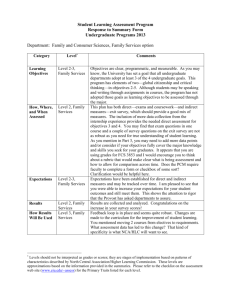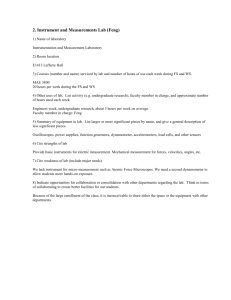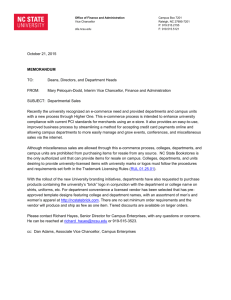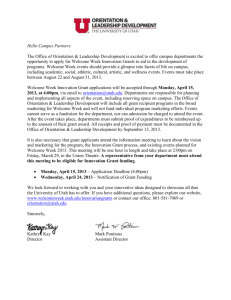Department server - University of Colorado Boulder
advertisement
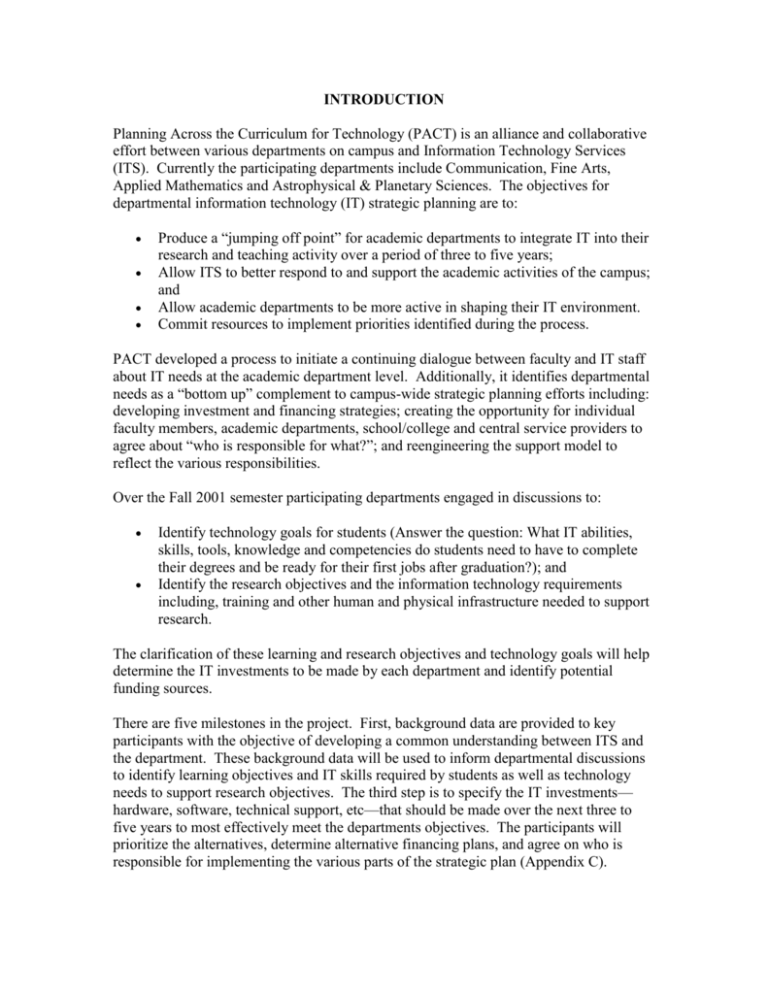
INTRODUCTION Planning Across the Curriculum for Technology (PACT) is an alliance and collaborative effort between various departments on campus and Information Technology Services (ITS). Currently the participating departments include Communication, Fine Arts, Applied Mathematics and Astrophysical & Planetary Sciences. The objectives for departmental information technology (IT) strategic planning are to: Produce a “jumping off point” for academic departments to integrate IT into their research and teaching activity over a period of three to five years; Allow ITS to better respond to and support the academic activities of the campus; and Allow academic departments to be more active in shaping their IT environment. Commit resources to implement priorities identified during the process. PACT developed a process to initiate a continuing dialogue between faculty and IT staff about IT needs at the academic department level. Additionally, it identifies departmental needs as a “bottom up” complement to campus-wide strategic planning efforts including: developing investment and financing strategies; creating the opportunity for individual faculty members, academic departments, school/college and central service providers to agree about “who is responsible for what?”; and reengineering the support model to reflect the various responsibilities. Over the Fall 2001 semester participating departments engaged in discussions to: Identify technology goals for students (Answer the question: What IT abilities, skills, tools, knowledge and competencies do students need to have to complete their degrees and be ready for their first jobs after graduation?); and Identify the research objectives and the information technology requirements including, training and other human and physical infrastructure needed to support research. The clarification of these learning and research objectives and technology goals will help determine the IT investments to be made by each department and identify potential funding sources. There are five milestones in the project. First, background data are provided to key participants with the objective of developing a common understanding between ITS and the department. These background data will be used to inform departmental discussions to identify learning objectives and IT skills required by students as well as technology needs to support research objectives. The third step is to specify the IT investments— hardware, software, technical support, etc—that should be made over the next three to five years to most effectively meet the departments objectives. The participants will prioritize the alternatives, determine alternative financing plans, and agree on who is responsible for implementing the various parts of the strategic plan (Appendix C). The Department of Communication committed to integrating technology across the curriculum in 1999, and has been a valuable resource in developing the PACT process. Thus, this report updates progress in meeting the goals of this commitment, assures the continuing dialog between ITS and Comm., and identifies the future vision for the department. A key step in developing sound strategic goals is identifying the technology learning objectives for students in each of the departments. The technology learning objective for the Department of Communication are listed next on page 3. 2 Department of Communication Technology Learning Objectives For Students The Communication Department commits to educating students for success in a multimedia society through the study of communication skills and practices, and technology-mediated communication. Broadly, this commitment: Provides access and experience with new information and communication technologies Examines the nature of human interaction with and through technologies Explores pragmatic and ethical perspectives on technology uses Develops critical and reflective use of communication and information technologies 1. To be able to apply basic skills to participate in class and complete assignments a. To be able to use a computer including keyboard skills b. To be able to use word processing and spreadsheet applications (Microsoft Office suite) c. To be able to use email, web browsers, and WebCT d. To be able to conduct effective Internet research e. To be able to cite Internet resources properly and to assess the quality of information f. To understand the basics of web design and web page editing 2. To be able to effectively incorporate technology into presentations and public speaking a. To be able to develop and deliver a multimedia presentation b. To be able to use PowerPoint c. To be able to integrate graphics, audio and other media into a presentation 3. To be able to use technology tools to conduct research a. To be able to use online library resources (Chinook, Infotrac) and other research tools b. How to use data management software (for ex, SPSS or other statistical applications) c. To be able to use video recording and editing (for ex, Adobe video editing software) 4. To be able to use technology for organizational, group and cultural communication a. To be able to use groupware--collaboration tools and distributed meeting systems b. To be able to work with groups online and across institutions (org comm. or cultural comm.) c. To be able to participate in and assess technology assisted collaborative composition and group decision-making 5. To develop assessment procedures for faculty, students and curricular integration a. Authorship of internet content b. Psychological implications and attitudes regarding communications technologies c. Interactional and relational implications of using communications technologies d. Societal implications of using technologies 3 BACKGROUND INFORMATION Mission Statement (from department website) The community of scholars within the Department of Communication examines problems of human interaction, participation, collaboration, deliberation, and decision-making across a wide variety of settings. While providing a solid foundation of the traditional areas of the field of communication, they are committed in our teaching and our research to spanning the boundaries between interpersonal, organizational, and public communication. Students completing a BA, MA or PhD degree are encouraged to synthesize social scientific and humanistic approaches to communication theory, research, and practice. Through courses, colloquia, guest lectures, and informal activities, the department encourages both students and faculty to engage current problems of communication in society. Program Description (from department website) The central focus of the discipline is the study of human communication in its many contexts, from the interpersonal interaction that occurs between friends and family, to the processes that help organizational groups succeed, to the communication necessary for effective participation in civic life. Across the discipline, this focus takes different forms. The Communication Department at CU-Boulder is distinguished by is focus on examining the nature and processes of interaction, and on the processes of participation, collaboration, deliberation, and decision-making. Through research, teaching, and service, faculty and students engage current problems of communication in society. Department faculty are prominent in their fields, serving as presidents of national and international associations of communication scholars, editors of influential research journals, authors of nationally adopted textbooks, and recipients of University-wide awards for excellence in teaching. A strong commitment to undergraduate education means that students electing Communication as their major have the opportunity to study directly with faculty, often in small seminars, independent studies, or honors work. Graduates of the department are skillful communicators and thoughtful critics of human interaction. Students at CU recognize both the quality of their classroom experience, and the importance of communication for their lives. Consequently, Communication is one of the most popular majors in the College of Arts and Sciences. Advanced study in the department offers individuals an opportunity to deepen their understanding of communication theory and research, and to use that understanding to address significant problems in contemporary social life. Graduate work at CU is personalized to meet each student's needs and interests and students and faculty interact frequently. Students are encouraged to pursue interests that intersect different areas of the discipline. Graduates of our M.A. and Ph.D. programs have consistently demonstrated success in both academic and other professional careers. 4 The department consists of 18 faculty, approximately 800 undergraduate majors and 50 graduate majors. Department Support In 1999, the faculty of the Department of Communication committed to a “Technology Across the Curriculum” (TAC) policy. The policy “envisions an undergraduate curriculum in which students experience a learning environment that is seamless in its integration of communication and information technologies with course content” (Department of Communication, A Proposal for Unit-Level Vision and Commitment to Uses of Technology in Education). The following initiatives were agreed to: The development of faculty and instructor skills in the use and evaluation of communication and information technology The development of at least one lower level course and two senior-level seminars focused on issues in technology and human communication The inclusion of at least one relevant communication technology based assignment in every undergraduate course. To achieve the goals set out in the policy, the department implemented a $5 per credit course fee approved by the students. The policy commits the department to providing faculty, graduate assistants and undergraduate work-study student time to develop instruction modules and workshops, to provide personal instruction to faculty, and to develop assessment procedures. Furthermore, it commits to acquiring technology for classroom use including the laptop computers, LCD projectors, and for the maintenance of equipment used in the Communication Observation lab (Hellems 3 and 5), the Communication Mobile LAN lab, and the technology-enhanced seminar room (Hellems 81). (See Appendix F for details of these facilities) ITS Support Media production services have been preparing graphics and digital audio files for the digital web tutorials also known as SPOTT (Self-paced online technology tutorials). The Wireless Systems Group has been working closely with Communication to develop the specifications for the technology-enhanced seminar room that is using wireless technology. The department and the wireless group are finalizing the Memorandum of Understanding for the services and responsibilities for this room as well. ATLAS provided a $15,000 grant to support the development of the seminar room. There are no open student computing labs affiliated with the Department of Communication, so there has been minimal interaction with Micro Systems Group (MSG). Distributed Academic Technology Coordinator 5 IDENTIFICATION OF TECHNOLOGY GOALS An iterative process between the IT faculty committee and ITS was used to both clarify and focus the learning objectives. Prior to identifying the learning objectives, background information was provided to participants to help them to think about what is possible. Background information includes: An overview of campus-wide IT services and a summary of new initiatives that indicate where the campus is investing in technology infrastructure during the next 3-5 years (Appendix A and B) A summary of IT learning programs at related departments at peer institutions (Appendix E); and Relevant articles on technology, teaching and learning. Once the technology learning objectives were finalized, a series of focus groups was conducted to determine if current technology investments are meeting the needs of students. Four focus group sessions were held for lower-division undergraduates, upperdivision undergraduates, and graduate students. Each of the constituent groups met separately. Undergraduate students provide valuable perspective on how well the department is meeting its stated mission, goals and objectives; and what additional IT training or skills would be of interest. Graduate students offer insight both as students and instructors. Faculty groups critically evaluate and synthesize the input of students and add the perspective of those who will actually integrate the IT skills into the curriculum of the department. Focus group discussion questions for students include: Describe the current uses of information technology in your department. What hardware, software and facilities are most important for completing course-related assignments in your major? What are the information technology-related learning objectives for the department? What should they be in the future? What IT abilities, skills, tools, knowledge and competencies do you need to have by the time you graduate? What are your ideas on how to accomplish these objectives? Do you have any comments on teaching with technology? Do you have any suggestions to improve the curriculum (what is missing)? Where do you think technology in your discipline is headed? These questions are representative of the starting points for focus group discussions. It is important to develop ad hoc follow up questions during the focus groups that generate a free-flowing discussion and that encourage the expression of different points of view. The results of the focus groups are summarized in a written report (Appendix D). The report identifies common themes that emerged from the focus group discussions. A faculty committee designated by the department used it to assess the effectiveness of current investments and for visioning the future direction of the department. 6 Findings The students desire to learn more about IT, although it is not easy for them to articulate exactly what they want to know. The student approval of technology course fee supports this need, but it is important to point out that the need for more IT skills was reiterated in the student focus group. Furthermore, there is a commitment by faculty to integrate IT into the curriculum. There is consistency between faculty and students on the basic technology skills required—operating a computer, word processing, email, Internet research, and the fundamentals of web design. Students do not know what existing resources are available to gain these skills. However, upper division undergraduates were the most aware of resources of campus. Consistently, students identify making a web page and using presentational software as their weakest skills. Students want progressive difficulty in assignments so that the IT skills they learn are cumulative and move beyond the basics. They suggest hands-on experience incorporated into classes that require the application of technology to effectively complete a project or assignment. Based on the focus groups, technology skills do improve from lower division to upper division undergraduate students (or at least the ability to articulate), but the skills acquired are not uniformly consistent Faculty have correctly identified that baseline of shared competencies is a problem. The challenge will be how to incorporate more advanced skills once the basic skills are acquired. Both faculty and students are concerned with faculty acquiring the technology skills needed to effectively incorporate technology skills into the curriculum. Additionally, access to adequate facilities and equipment, as well as faculty understanding of the equipment, are essential to successfully integrate technology. Students want to know what technologies major companies are using, and what are the real world applications for these technologies. AREAS OF INVESTMENT Wireless LAN The department is developing a technology enhanced seminar room in Hellems 81. The purpose is to better coordinate the technology resources of the department and the interrelated activities it makes possible. The room will be an excellent facility for identifying effective ways to integrate technology into the curriculum. Originally scheduled to open fall 2001, it has been delayed pending an agreement for wireless services. The Communication Department and ITS are finalizing the Memorandum of Understanding and the expected responsibilities for operation costs. 7 This seminar room is at the leading edge of technology use, and can be used as a model for other departments that want to incorporate IT into the curriculum. Tutorials The department is using course fees for the development and delivery of SPOTT (SelfPaced Online Technology Tutorials). The first tutorial being developed is “How to Make a Website” the second tutorial is on the use of presentation software. These tutorials meet the most critical demands identified by students in the focus groups. The department has developed a budget for the personnel needed to develop and maintain the tutorials. It may be possible for other departments to use these tutorials as a resource in the future. Department server As Comm. becomes more sophisticated in its use of technology, it anticipates wanting to add additional applications. The acquisition of its own server will allow flexibility to add applications, for example: providing more interactivity on its website, supporting their digital media needs, offering on-line calendaring, and creating a database backend. A student intern hired by Comm. is conducting a needs assessment for a new server, and writing a report on the pros and cons of a department maintained server. There has been a proliferation of servers on campus, and ITS should identify server maintenance issues on campus as well as website maintenance needs and concerns. Support personnel Currently, faculty maintain equipment that has been purchased by the department. Additional facilities and equipment have increased the burden of this maintenance. The department needs additional support personnel to adequately ensure the safeguarding and coordination of the IT investments. The campus needs to consider how to efficiently provide support for the increasing investment in technology by departments. Peer-to-peer networking for the classroom Comm. anticipates peer-to-peer networking as the next investment for its technology enhanced media seminar room. 8 CONCLUSION Now that investments have been identified, the most important vision for the future is to ensure that they are used frequently and effectively. The goal is to have continuous activity and to build momentum to keep moving forward. At this point, an ongoing dialog between the Department of Communication and ITS must continue to outline the responsibilities to successfully fulfill the goals identified. Additionally, ITS should provide more information on its future direction to help the department identify where it should make its investments. Participants Students—Lauren Alweis, Jessica Bertini, James Bingham, Jason Bitensky, Nicole Brant-Zawadzki, Laura Bush, Bridget Cowan, Josh Freidfertig, Heather FroelichOlmsted, Angela Gilman, Laura Graham, Michael Grosh, Sara Helf, Rigo Hernandez, Elizabeth Hudson, Matt Ippolito, Kate Larsen, Janet Lee, Meghan Mayhood, Lindsey Maxon, Ryan McCloskey, Joe McErlane, Travis McNeil, Mike Medina, Allison Meyers, Keagan Resler, Jennifer Sightler, Daniel Stewart, Kate Treanor, Lexie Wagner, Judy Wehry, Magui Yordan Communication—Robert Craig, Alex Heintzman, Michele Jackson, Tim Kuhn, Paul Turpin ITS—Stephanie Duncan, Gary Franz, Jenifer Martin, Barbara McFall 9
